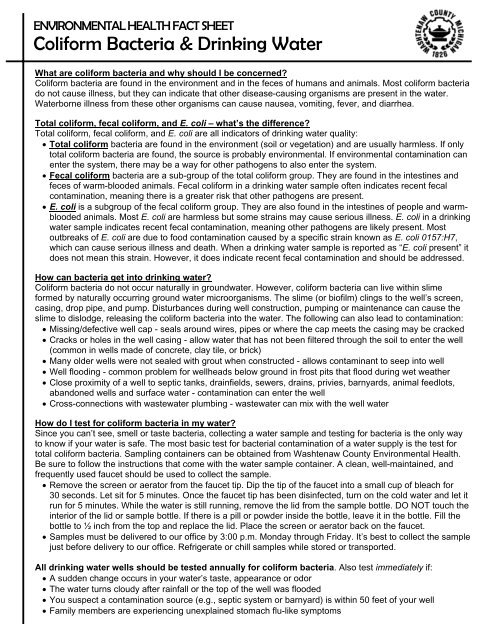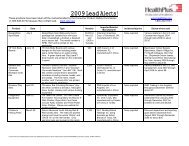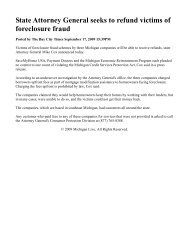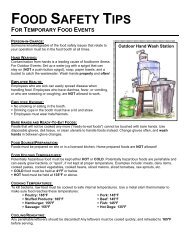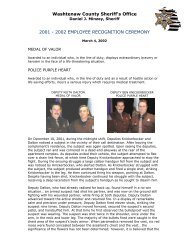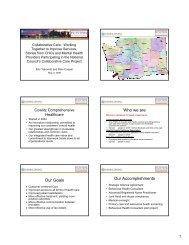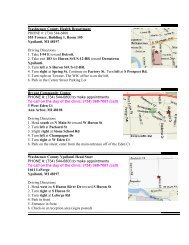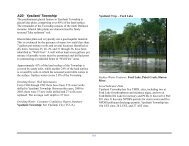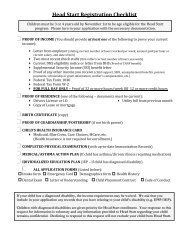Coliform Bacteria Fact Sheet - Washtenaw County
Coliform Bacteria Fact Sheet - Washtenaw County
Coliform Bacteria Fact Sheet - Washtenaw County
Create successful ePaper yourself
Turn your PDF publications into a flip-book with our unique Google optimized e-Paper software.
ENVIRONMENTAL HEALTH FACT SHEET<br />
<strong>Coliform</strong> <strong>Bacteria</strong> & Drinking Water<br />
What are coliform bacteria and why should I be concerned?<br />
<strong>Coliform</strong> bacteria are found in the environment and in the feces of humans and animals. Most coliform bacteria<br />
do not cause illness, but they can indicate that other disease-causing organisms are present in the water.<br />
Waterborne illness from these other organisms can cause nausea, vomiting, fever, and diarrhea.<br />
Total coliform, fecal coliform, and E. coli – what’s the difference?<br />
Total coliform, fecal coliform, and E. coli are all indicators of drinking water quality:<br />
• Total coliform bacteria are found in the environment (soil or vegetation) and are usually harmless. If only<br />
total coliform bacteria are found, the source is probably environmental. If environmental contamination can<br />
enter the system, there may be a way for other pathogens to also enter the system.<br />
• Fecal coliform bacteria are a sub-group of the total coliform group. They are found in the intestines and<br />
feces of warm-blooded animals. Fecal coliform in a drinking water sample often indicates recent fecal<br />
contamination, meaning there is a greater risk that other pathogens are present.<br />
• E. coli is a subgroup of the fecal coliform group. They are also found in the intestines of people and warmblooded<br />
animals. Most E. coli are harmless but some strains may cause serious illness. E. coli in a drinking<br />
water sample indicates recent fecal contamination, meaning other pathogens are likely present. Most<br />
outbreaks of E. coli are due to food contamination caused by a specific strain known as E. coli 0157:H7,<br />
which can cause serious illness and death. When a drinking water sample is reported as “E. coli present” it<br />
does not mean this strain. However, it does indicate recent fecal contamination and should be addressed.<br />
How can bacteria get into drinking water?<br />
<strong>Coliform</strong> bacteria do not occur naturally in groundwater. However, coliform bacteria can live within slime<br />
formed by naturally occurring ground water microorganisms. The slime (or biofilm) clings to the well’s screen,<br />
casing, drop pipe, and pump. Disturbances during well construction, pumping or maintenance can cause the<br />
slime to dislodge, releasing the coliform bacteria into the water. The following can also lead to contamination:<br />
• Missing/defective well cap - seals around wires, pipes or where the cap meets the casing may be cracked<br />
• Cracks or holes in the well casing - allow water that has not been filtered through the soil to enter the well<br />
(common in wells made of concrete, clay tile, or brick)<br />
• Many older wells were not sealed with grout when constructed - allows contaminant to seep into well<br />
• Well flooding - common problem for wellheads below ground in frost pits that flood during wet weather<br />
• Close proximity of a well to septic tanks, drainfields, sewers, drains, privies, barnyards, animal feedlots,<br />
abandoned wells and surface water - contamination can enter the well<br />
• Cross-connections with wastewater plumbing - wastewater can mix with the well water<br />
How do I test for coliform bacteria in my water?<br />
Since you can’t see, smell or taste bacteria, collecting a water sample and testing for bacteria is the only way<br />
to know if your water is safe. The most basic test for bacterial contamination of a water supply is the test for<br />
total coliform bacteria. Sampling containers can be obtained from <strong>Washtenaw</strong> <strong>County</strong> Environmental Health.<br />
Be sure to follow the instructions that come with the water sample container. A clean, well-maintained, and<br />
frequently used faucet should be used to collect the sample.<br />
• Remove the screen or aerator from the faucet tip. Dip the tip of the faucet into a small cup of bleach for<br />
30 seconds. Let sit for 5 minutes. Once the faucet tip has been disinfected, turn on the cold water and let it<br />
run for 5 minutes. While the water is still running, remove the lid from the sample bottle. DO NOT touch the<br />
interior of the lid or sample bottle. If there is a pill or powder inside the bottle, leave it in the bottle. Fill the<br />
bottle to ½ inch from the top and replace the lid. Place the screen or aerator back on the faucet.<br />
• Samples must be delivered to our office by 3:00 p.m. Monday through Friday. It’s best to collect the sample<br />
just before delivery to our office. Refrigerate or chill samples while stored or transported.<br />
All drinking water wells should be tested annually for coliform bacteria. Also test immediately if:<br />
• A sudden change occurs in your water’s taste, appearance or odor<br />
• The water turns cloudy after rainfall or the top of the well was flooded<br />
• You suspect a contamination source (e.g., septic system or barnyard) is within 50 feet of your well<br />
• Family members are experiencing unexplained stomach flu-like symptoms
<strong>Coliform</strong> <strong>Bacteria</strong> and Drinking Water<br />
Page 2<br />
What do the results mean?<br />
If coliform bacteria are present in your drinking water, your risk of contracting a water-borne illness is<br />
increased. A positive total coliform sample should be considered an indication of pollution in your well.<br />
Positive fecal coliform results, especially positive E. Coli results, should be considered indication of fecal<br />
pollution in your well.<br />
What should I do if coliform bacteria are detected in my well?<br />
Be concerned but do not panic if coliform bacteria are detected. Resample immediately if you have a positive<br />
sample before you treat, repair or replace the well. If you receive a second positive sample for total coliforms,<br />
or if the initial sample is positive for fecal coliforms, do not drink the water. Bring the water to a rolling boil for<br />
three minutes to kill the bacteria. You may also want to use bottled water as a temporary water source.<br />
How can I eliminate coliform bacteria from my well water?<br />
If coliform bacteria are present, the source of the problem should be identified. Resampling from several<br />
locations within the water system may be helpful. The entire water system may need to be thoroughly flushed<br />
and disinfected before a negative bacteria sample can be obtained. A well drilling contractor or a <strong>Washtenaw</strong><br />
<strong>County</strong> Sanitarian can help identify structural defects in the system. After the defects are corrected, the system<br />
should be disinfected and the water retested before drinking.<br />
How do I chlorinate/disinfect my well?<br />
1) Draw off 4 gallons of water into a 5-gallon bucket. Mix 1 gallon liquid bleach with the water. (Liquid bleach<br />
should not be used with a steel well casing; use granular chlorine instead.)<br />
2) Turn off the power to the well pump. Remove the well cap; be careful if screws or bolts are rusty. (If the<br />
well cap has one large bolt in the center, do not remove it. Have a licensed well contractor disinfect your<br />
well. If your wellhead is buried or if you have a shallow well, contact a Sanitarian at (734) 222-3800.)<br />
3) Pour the bleach mixture into the well between the casing and the cross bar or “T” bar. DO NOT pour the<br />
mixture into the 1” center hole. Newer wells have markings or a statement next to the correct hole. Try not<br />
to get the solution on the wires inside the well.<br />
4) Connect a clean hose to an outside spigot and extend it into the well 4 feet.<br />
5) Turn the power on to the well pump. Turn on the spigot connected to the hose in the well and let water run<br />
in the well for 20 minutes. This distributes the disinfectant throughout the well system. Turn the spigot off.<br />
6) Turn off the power supply to the well pump. Once the power is off, remove the hose from the well and put<br />
the well cap back on the well using the existing nuts and bolts.<br />
7) Turn on the power to the well pump. All work is now completed on the wellhead.<br />
8) Now it’s time to distribute the bleach to the pipes inside the home. Turn on each indoor and outdoor water<br />
faucet, run the shower, clothes washer, dishwasher, and any outside hydrants or plumbing fixtures in other<br />
buildings, and flush each toilet a couple of times. Allow cold water to run until you can smell bleach, then<br />
turn off all the faucets. (Note: Some water softening units should not be chlorinated; contact your water<br />
softening company before disinfection to see if you should bypass the softening system.)<br />
9) Allow the solution to stay in the system for a minimum of eight hours, or overnight. During this time you<br />
should not drink, bathe, wash clothes or cook with the water, but you can use it for toilet flushing.<br />
10) After the solution has been in the system for a minimum of eight hours, connect a hose to an outside spigot<br />
and allow water to run onto the ground for 20-30 minutes to flush the bleach from the system. Try to keep<br />
the water away from your drainfield and any plants or trees if possible. Turn off the spigot and then run<br />
each indoor and outdoor water faucet for 2-3 minutes to remove the solution that was in the pipes.<br />
11) It is now time to collect the water sample. Follow the water sampling instructions that came with the bottle.<br />
Where can I get more information?<br />
<strong>Washtenaw</strong> <strong>County</strong> Department of Public Health - Environmental Health Division<br />
705 N. Zeeb Rd., P.O. Box 8645, Ann Arbor, MI 48107-8645<br />
(734) 222-3800<br />
www.e<strong>Washtenaw</strong>.org Rev. 7/13


